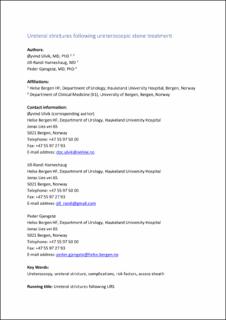Ureteral Strictures Following Ureteroscopic Stone Treatment
Journal article, Peer reviewed
Accepted version
Permanent lenke
https://hdl.handle.net/11250/2757309Utgivelsesdato
2021Metadata
Vis full innførselSamlinger
- Department of Clinical Medicine [2066]
- Registrations from Cristin [9791]
Sammendrag
Background and Purpose: Ureteral stricture is a rare, but serious complication following ureteroscopy (URS) for stones. The aim of this study was to investigate how many patients ended up with a ureteral stricture after URS at our hospital and how these were treated. We also wanted to identify potential risk factors for postendoscopic stricture formation.
Materials and Methods: A retrospective evaluation of 1001 URSs for stone treatment at the day-case surgery unit between 2013 and 2018 was performed. Data on pretreatment status, the surgical procedure, and follow-up were recorded. Exact χ2 and independent samples t-tests were used comparing data among those who developed strictures and those who did not. Multiple logistic regression was performed analyzing risk factors for stricture formation.
Results: In total, 1001 URSs were performed in 725 patients, 289 women and 436 men. Of these, 995 cases were eligible for analysis. At follow-up with CT after 3 months, 28 (3.0%) strictures were identified. Of these, 20 received endourologic treatment with balloon dilatation of which 15 (75%) were effective. Definitive treatment in the 13 patients with failed or unattempted endourologic treatment included nephrectomy, reconstructive surgery, permanent nephrostomy, or observation with no further treatment. In multiple regression analysis, use of ureteral access sheath (UAS; odds ratio [OR] 4.6, p = 0.011), ureteral perforation (OR 11.8, p < 0.0001), and surgical time >60 minutes (OR 5.7, p < 0.005) were found to be risk factors for stricture formation.
Conclusion: Ureteral stricture is a rare complication of URS. Balloon dilatation should be the first line of treatment. Use of UAS, perforation, and excessive operating time were found to be risk factors for postendoscopic ureteral stricture formation. Special attention to these risk factors should be given to reduce the incidence of ureteral strictures.
